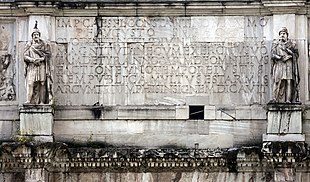Dakere

Dakere (latin: Daci; græsk: Δάκοι,[2] Δάοι,[2] Δάκαι[3]) var et indoeuropæisk folkeslag i det kulturelle område Dakien omkring år 0, nær Karpaterne og Sortehavets vestbred. De bliver ofte betragtet som en undergruppe af thrakerne.[4]
Området de beboede omfatter hovedsageligt de moderne lande Rumænien og Moldova, samt dele af Ukraine,[5] Østserbien, Nordbulgarien, Slovakiet,[6] Ungarn og det sydlige Polen.[5] Dakerne og de lignende getere[7] talte dakisk, som er beslægtet med thrakisk og kan have været en undergruppe af samme.[8][9] Dakernes kultur var i en vis udstrækning påvirket af nabofolket skyterne og den keltiske invasion i 300-tallet.
Referencer
- ^ Westropp 2003, s. 104.
- ^ a b Strabo & 20 AD, VII 3,12.
- ^ Dionysius Periegetes, Graece et Latine, Volume 1, Libraria Weidannia, 1828, p. 145.
- ^ Waldman & Mason 2006, s. 205 "The Dacians were a people of present-day Romania, a subgroup of THRACIANS, who had significant contacts with the ROMANS from the mid-second century B.C.E. to the late third century C.E."
- ^ a b Nandris 1976, s. 731.
- ^ Husovská 1998, s. 187.
- ^ The Cambridge Ancient History (Volume 10) (2nd udgave). Cambridge University Press. 1996. J. J. Wilkes mentions "the Getae of the Dobrudja, who were akin to the Dacians"; (p. 562)
- ^ Fisher 2003, s. 570.
- ^ Rosetti 1982, s. 5.
- Litteratur
- Fisher, Iancu (2003). Les substrats et leur influence sur les langues romanes: la Romania du Sud-Est / Substrate und ihre Wirkung auf die romanischen Sprachen: Sudostromania in Romanische Sprachgeschichte. Mouton De Gruyter. ISBN 978-3-110-14694-3.
- Husovská, Ludmilá (1998). Slovakia: walking through centuries of cities and towns. Príroda. ISBN 978-8-007-01041-3.
- Nandris, John (1976). Friesinger, Herwig; Kerchler, Helga; Pittioni, Richard; Mitscha-Märheim, Herbert (red.). "The Dacian Iron Age – A Comment in a European Context". Archaeologia Austriaca (Festschrift für Richard Pittioni zum siebzigsten Geburtstag udgave). Vienna: Deuticke. 13 (13-14). ISBN 978-3-700-54420-3. ISSN 0003-8008.
- Rosetti, A. (1982). La linguistique Balkanique in Revue roumaine de linguistique, volume 27. Editions de l'Academie de la RSR.
- Waldman, Carl; Mason, Catherine (2006). Encyclopedia of European Peoples. Infobase Publishing. ISBN 1438129181.
- Westropp, Hodder M. (2003). Handbook of Egyptian, Greek, Etruscan and Roman Archeology. Kessinger Publishing. ISBN 978-0-766-17733-8.
Eksterne henvisninger
Medier brugt på denne side
Forfatter/Opretter:
|
Detail from the Arch of Constantine in Rome.

